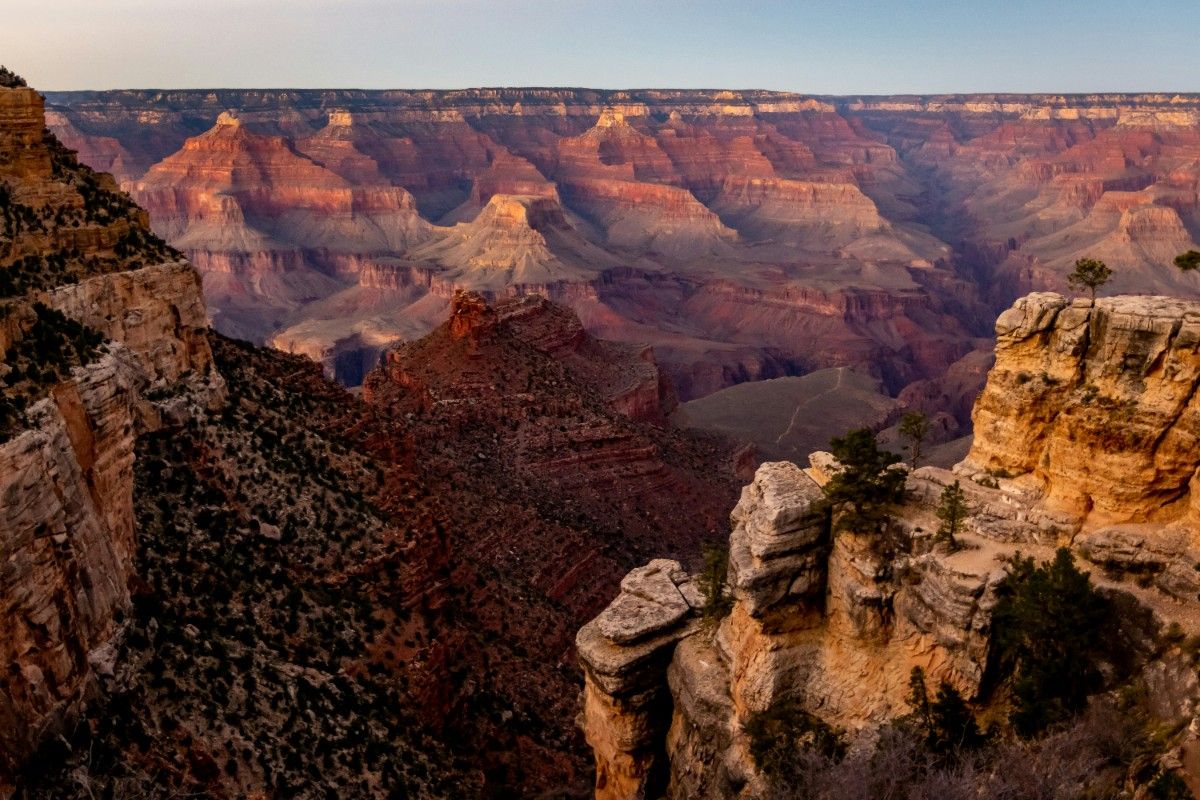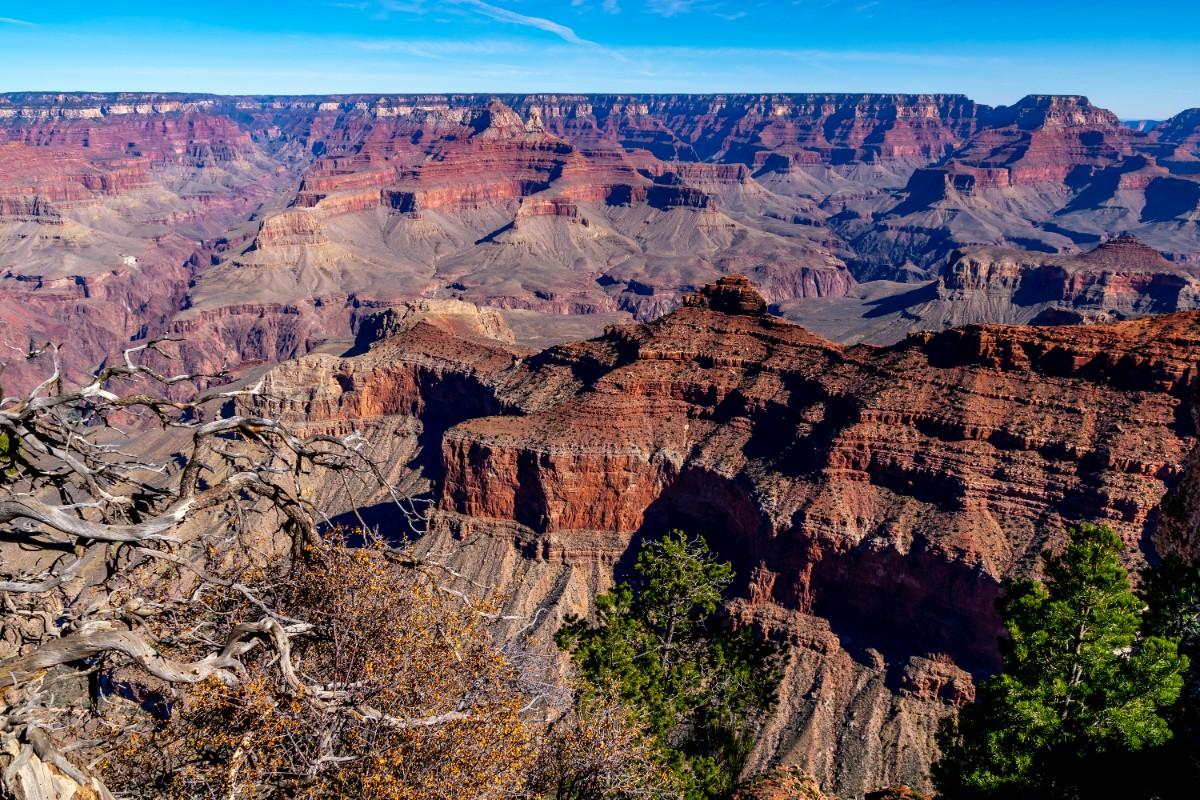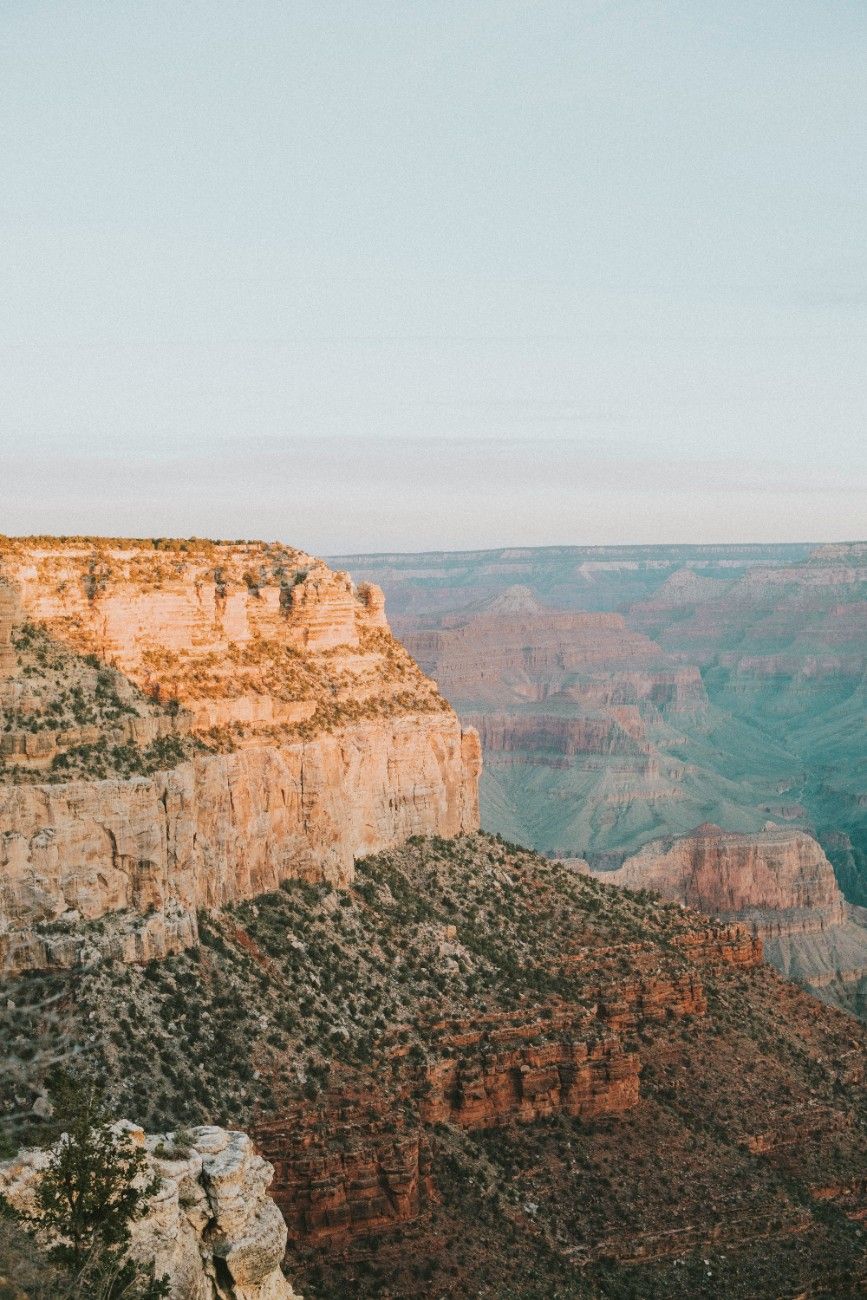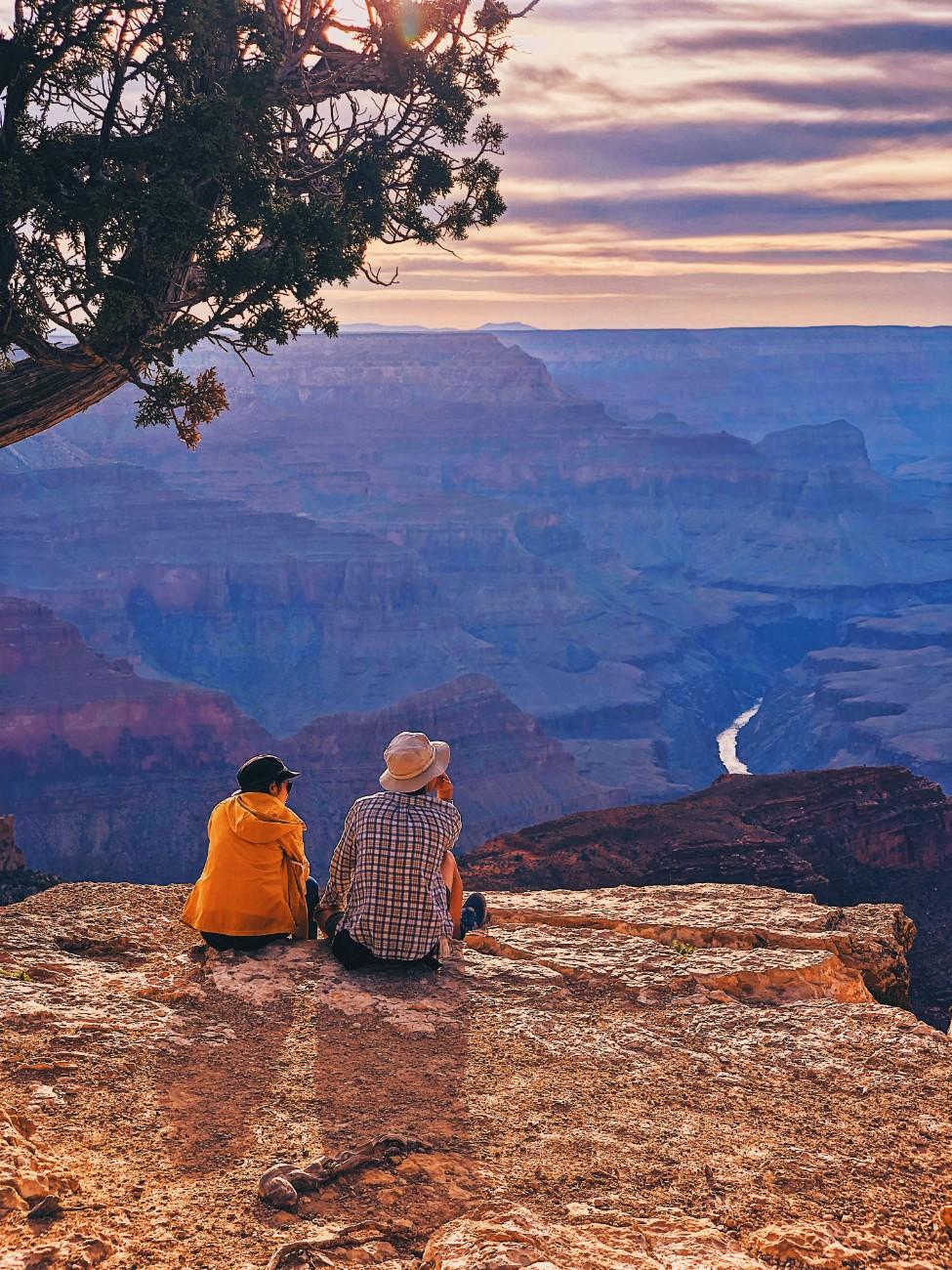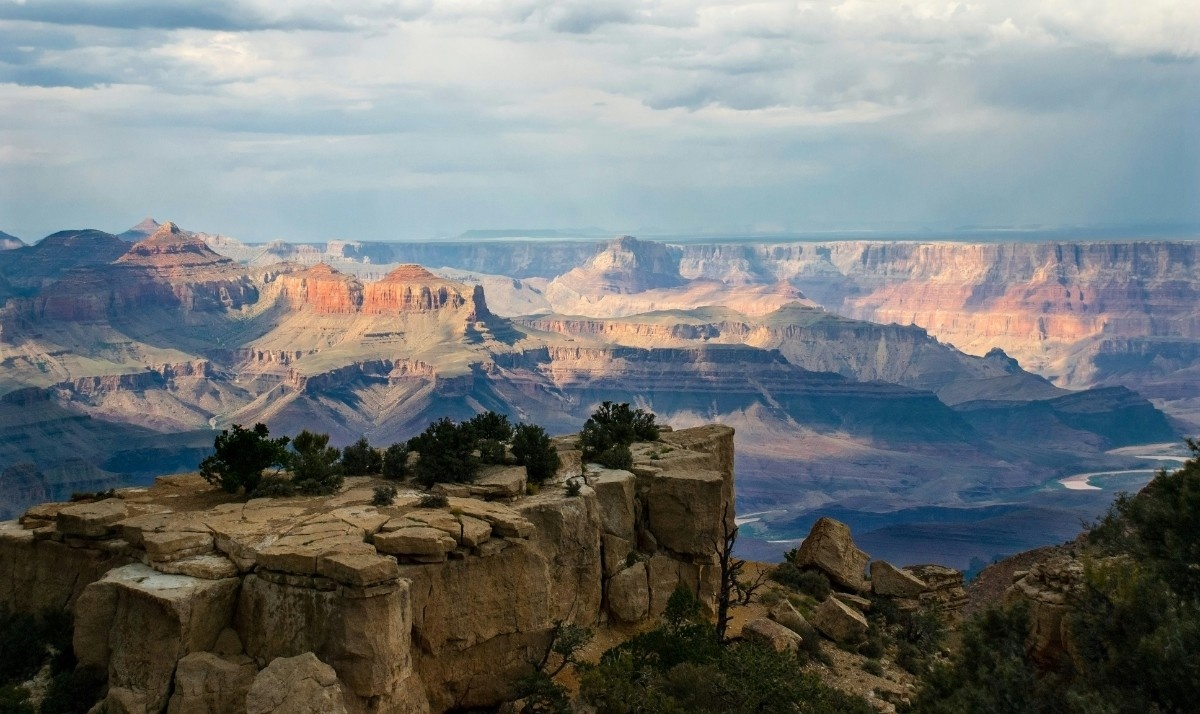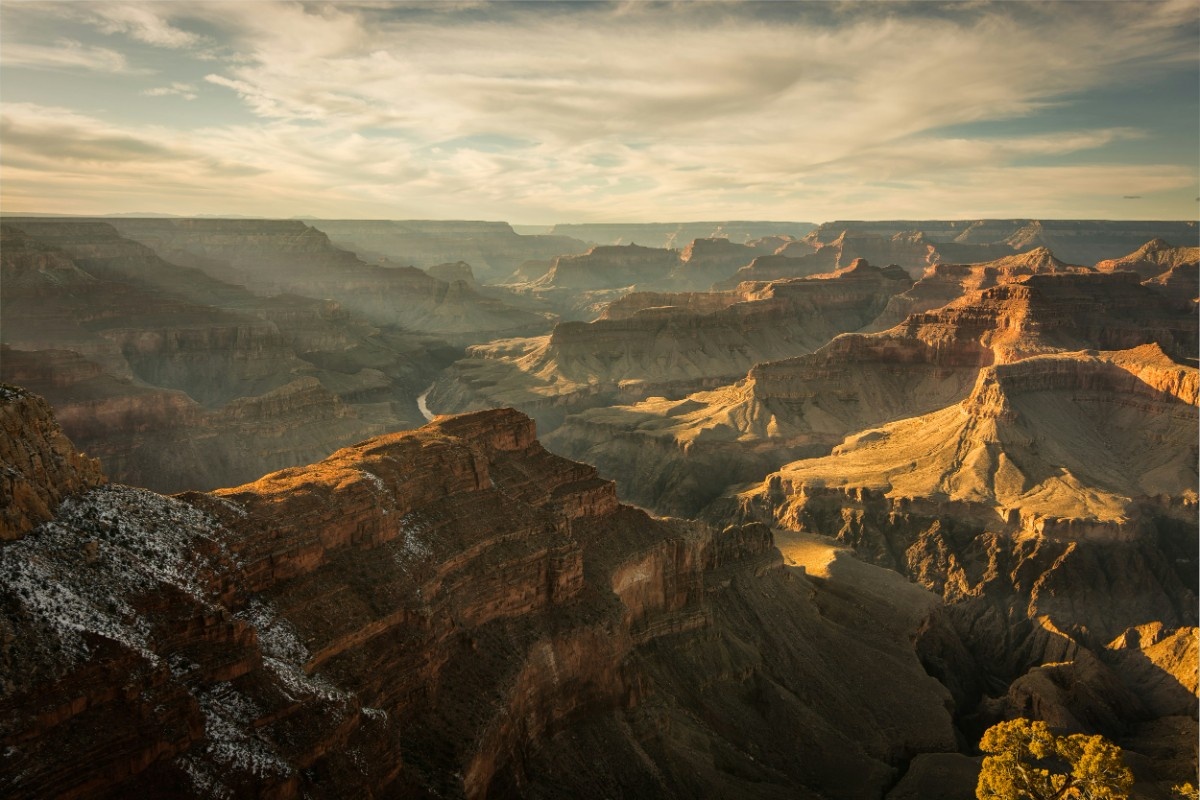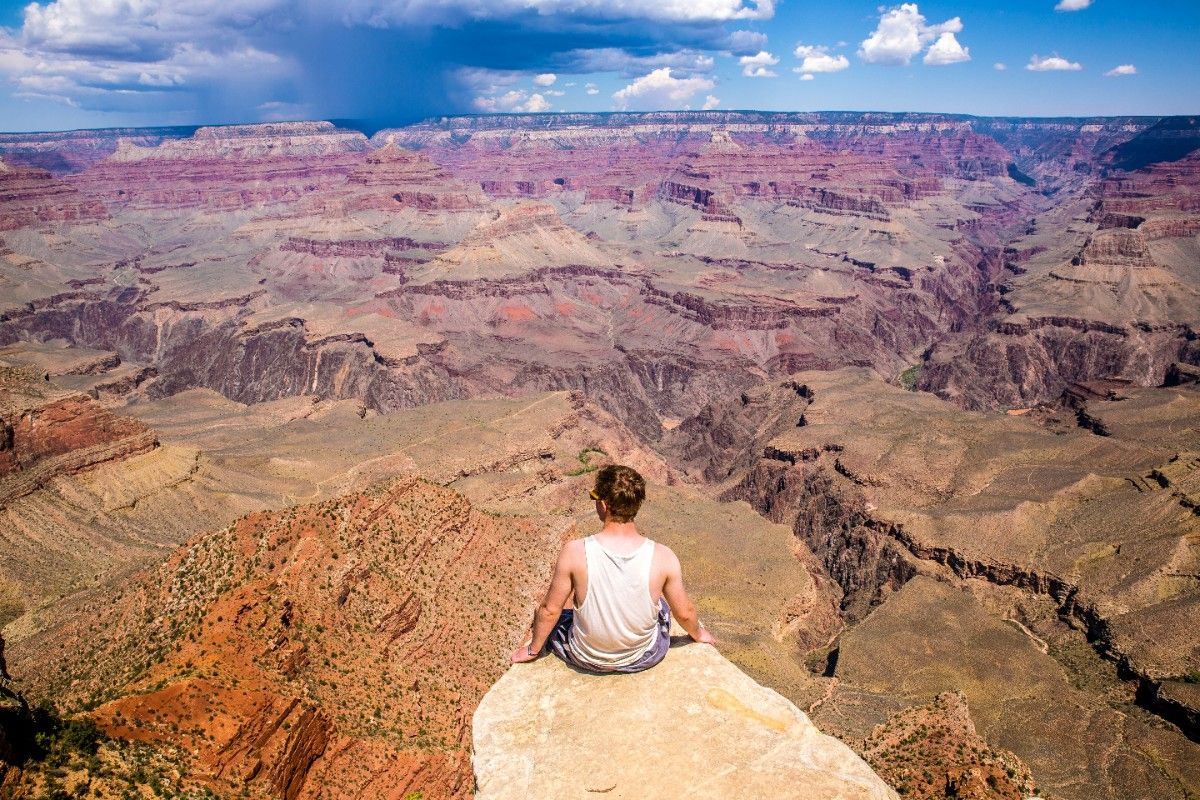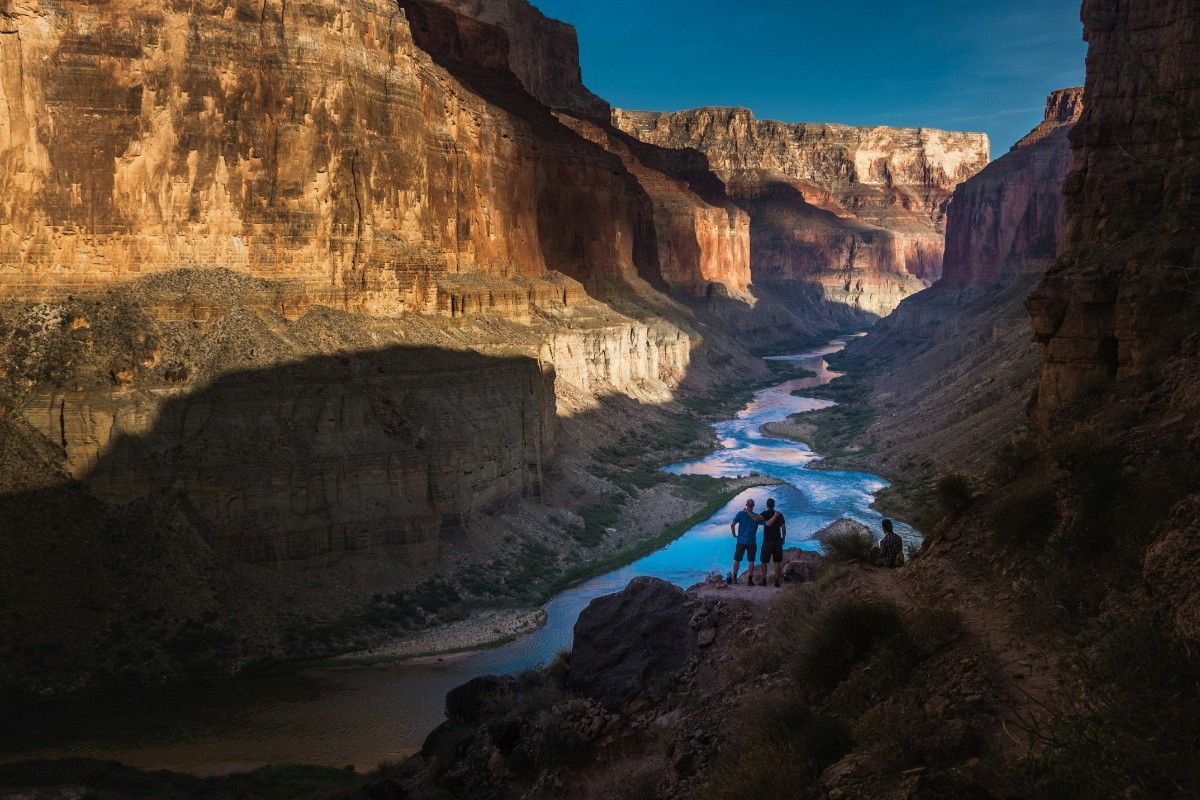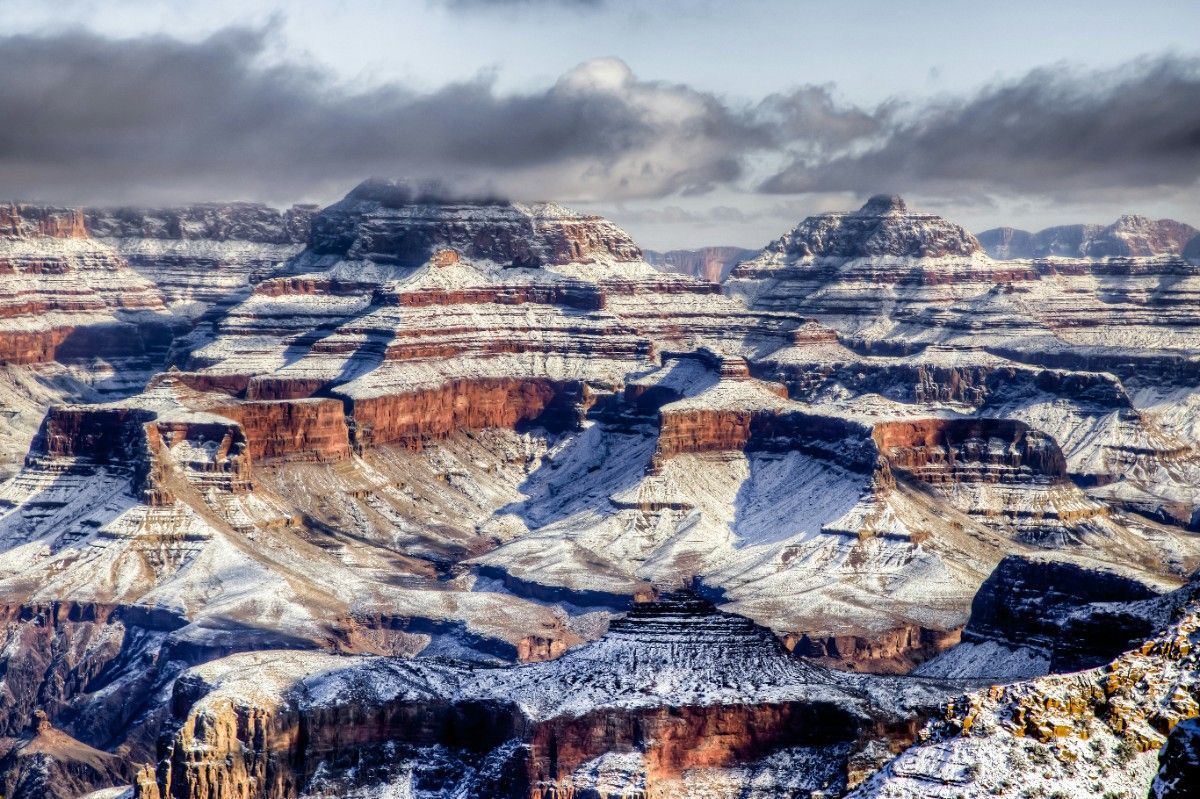The Grand Canyon National Park, located in the state of Arizona, United States, is a truly awe-inspiring natural wonder that attracts millions of visitors each year. Spanning over 1.2 million acres, this national park is home to the iconic Grand Canyon, a vast and deep gorge carved by the mighty Colorado River over millions of years. The park offers visitors a chance to witness the breathtaking beauty of the canyon, explore its diverse ecosystems, and learn about its rich geological and cultural history.
Geology and Formation of the Grand Canyon
The Colourful Layers of the Grand Canyon
The Grand Canyon is a masterpiece of geological wonder, showcasing an array of colourful rock layers that tell the story of Earth's history. The canyon's walls are like pages in a book, each layer revealing a different chapter in the planet's past. The oldest rocks, the Vishnu Basement Rocks, are found at the bottom of the canyon and date back nearly 2 billion years. These dark, metamorphic rocks form the foundation upon which the rest of the canyon's layers have been laid.
As you ascend the canyon walls, you'll encounter younger rock layers, each with its own unique characteristics and stories to tell. The Grand Canyon Supergroup, a collection of sedimentary and volcanic rocks, sits atop the Vishnu Basement Rocks and represents a period of sediment deposition and volcanic activity that occurred between 1.2 billion and 740 million years ago. These rocks are followed by the Tonto Group, which includes the Tapeats Sandstone, Bright Angel Shale, and Muav Limestone, all deposited during the Cambrian Period, around 550 million years ago.
The next layers in the sequence, the Temple Butte Formation and the Redwall Limestone, were deposited during the Devonian and Mississippian Periods, respectively. The Redwall Limestone, in particular, is a striking feature of the canyon, forming prominent cliffs and towering buttes. Above these layers, you'll find the Supai Group, Hermit Shale, Coconino Sandstone, Toroweap Formation, and Kaibab Limestone, all deposited during the Permian Period, between 300 and 250 million years ago.
Carving the Grand Canyon: The Power of the Colorado River
The Grand Canyon as we know it today is the result of the tireless work of the mighty Colorado River. Over the past 5 to 6 million years, the river has carved its way through the layers of rock, creating the vast and deep gorge we see today. The process began when the Colorado Plateau began to uplift due to tectonic activity, causing the river to cut downward through the rising landscape.
As the river continued to erode the plateau, it exposed the various rock layers, each with its own unique resistance to erosion. Harder layers, like the Kaibab Limestone and the Redwall Limestone, form steep cliffs and towering buttes, while softer layers, like the Bright Angel Shale and the Hermit Shale, create gentle slopes and wide plateaus.
The process of erosion is ongoing, with the Colorado River continuing to shape the canyon's landscape. In addition to the river's flow, other factors such as weathering, rockfalls, and tributary streams also contribute to the canyon's evolution. With each passing day, the Grand Canyon grows deeper and wider, offering a constantly changing and awe-inspiring landscape for visitors to explore and marvel at the power of nature.
Exploring the South Rim of the Grand Canyon
Grand Canyon Village: The Hub of the South Rim
The Grand Canyon Village, located on the South Rim of the Grand Canyon National Park, serves as the main hub for visitors exploring this iconic area. The village offers a wide range of amenities and services, making it an ideal base for your canyon adventures. Here, you'll find several lodging options, including the historic El Tovar Hotel, Bright Angel Lodge, Kachina Lodge, and Thunderbird Lodge, each offering comfortable accommodations and stunning views of the canyon.
In addition to lodging, the Grand Canyon Village features a variety of dining options, from casual cafes to fine dining restaurants. The El Tovar Dining Room, known for its elegant atmosphere and regional cuisine, is a popular choice among visitors. For a more casual experience, the Bright Angel Lodge offers a family-friendly restaurant and an ice cream parlour.
The village also serves as a starting point for many of the South Rim's most popular activities. The Grand Canyon Visitor Centre, located in the village, is an excellent resource for information on hiking trails, ranger-led programs, and park history. From here, you can easily access the Rim Trail, a paved and mostly flat path that runs along the canyon's edge, offering breathtaking views and connecting to various viewpoints and attractions.
Mather Point and the Rim Trail: Spectacular Views and Easy Access
One of the most popular viewpoints on the South Rim is Mather Point, named after Stephen Mather, the first director of the National Park Service. This easily accessible viewpoint offers breathtaking panoramic views of the Grand Canyon, making it a must-visit spot for all visitors.
Mather Point is located just a short walk from the Grand Canyon Visitor Centre and is the starting point for the Rim Trail, a paved and mostly flat path that stretches along the canyon's edge. The Rim Trail is perfect for visitors of all ages and abilities, offering a leisurely way to explore the South Rim and take in the stunning vistas.
As you walk along the Rim Trail, you'll encounter several other viewpoints, each offering a unique perspective of the canyon. Yavapai Point, located about 0.7 miles east of Mather Point, features an observation station with outdoor exhibits and a bookstore. Further along the trail, you'll find Verkamp's Visitor Centre, housed in a historic building that once served as a curio shop and now offers park information and souvenirs.
Hiking into the Canyon: The Bright Angel and South Kaibab Trails
For those looking to venture below the rim and explore the Grand Canyon's inner reaches, the South Rim offers two popular hiking trails: the Bright Angel Trail and the South Kaibab Trail. Both trails offer challenging but rewarding experiences, showcasing the canyon's geology, ecology, and breathtaking beauty.
The Bright Angel Trail, which begins near the Bright Angel Lodge, is a well-maintained and heavily trafficked trail that descends 4,380 feet to the Colorado River. The trail offers rest houses and water stations along the way, making it a popular choice for day hikes and overnight backpacking trips. However, it is essential to remember that hiking down is optional, while hiking back up is mandatory, so plan your trip accordingly and be prepared for the strenuous climb out of the canyon.
The South Kaibab Trail, which starts near Yaki Point, offers a steeper and more exposed route into the canyon. This trail is a favourite among experienced hikers, offering dramatic views and a sense of solitude. Like the Bright Angel Trail, the South Kaibab Trail is a challenging hike that requires proper preparation and planning.
Whether you choose to hike the Bright Angel or the South Kaibab Trail, be sure to follow park guidelines, carry plenty of water, and wear appropriate footwear and clothing. Remember, the journey into the Grand Canyon is just as rewarding as the destination, offering a chance to immerse yourself in the park's natural wonders and experience the awe-inspiring beauty of this iconic landscape.
Discovering the North Rim of the Grand Canyon
The Road Less Travelled: Exploring the North Rim
While the South Rim of the Grand Canyon is the most popular and easily accessible area of the park, the North Rim offers a more secluded and serene experience for those willing to venture off the beaten path. Open seasonally from mid-May to mid-October, depending on weather conditions, the North Rim sits at a higher elevation than the South Rim, resulting in cooler temperatures and a more forested landscape.
One of the best ways to explore the North Rim is by taking a scenic drive along the Cape Royal Road. This 23-mile route winds through the Kaibab National Forest, offering stunning views of the canyon and the surrounding landscape. Along the way, you'll encounter several viewpoints and hiking trails, each offering a unique perspective of the Grand Canyon's beauty.
The road culminates at Cape Royal, a breathtaking viewpoint that offers panoramic vistas of the canyon and the distant South Rim. From here, you can take a short walk to Angels Window, a natural arch that frames the canyon's depths, creating a picturesque scene that is perfect for photography enthusiasts.
Point Imperial: The Highest Viewpoint on the North Rim
Another must-visit spot on the North Rim is Point Imperial, the highest viewpoint in the Grand Canyon National Park at 8,803 feet above sea level. This viewpoint offers a unique perspective of the canyon, showcasing the vibrant colours of the rock layers and the vast expanse of the surrounding landscape.
From Point Imperial, you can see the Painted Desert to the east and the Kaibab Plateau to the north, as well as several prominent landmarks within the canyon, such as Mount Hayden and Saddle Mountain. The viewpoint is easily accessible via a short, paved trail from the parking area, making it a perfect stop for visitors of all ages and abilities.
In addition to the stunning views, Point Imperial is also an excellent spot for stargazing. Due to its remote location and high elevation, the North Rim offers some of the darkest night skies in the country, providing an opportunity to marvel at the Milky Way and countless stars that illuminate the canyon's depths.
Hiking the North Kaibab Trail: A Challenging and Rewarding Adventure
For those seeking a more immersive experience, the North Rim offers several hiking trails that showcase the area's natural beauty. The most famous of these is the North Kaibab Trail, which descends from the rim to the Colorado River, offering hikers a chance to explore the canyon's inner reaches and experience its diverse ecosystems.
The North Kaibab Trail is a strenuous and challenging hike, dropping 5,850 feet over 14 miles to reach the river. Along the way, hikers will encounter steep switchbacks, exposed sections, and dramatic changes in elevation and climate. However, the rewards are well worth the effort, as the trail offers stunning views of the canyon's geology, waterfalls, and unique plant and animal life.
Due to the North Kaibab Trail's difficulty and remote location, it is essential to be well-prepared and self-sufficient when attempting this hike. Hikers should carry plenty of water, food, and appropriate gear, as well as be prepared for extreme temperature changes and potential hazards such as rockfalls and wildlife encounters. For those who are up to the challenge, hiking the North Kaibab Trail is an unforgettable way to experience the Grand Canyon's rugged beauty and immerse oneself in the park's wild and untamed landscapes.
Wildlife and Ecosystems of the Grand Canyon
The Diverse Habitats of the Grand Canyon
The Grand Canyon is home to a remarkable diversity of plant and animal life, adapted to the varied and often harsh conditions found throughout the park. From the desert scrub at the canyon's bottom to the montane forests on the North Rim, the park's ecosystems support a wide array of species, each playing a vital role in the canyon's ecological balance.
At the lowest elevations, the canyon's floor is characterised by a hot and arid desert environment, where temperatures can soar above 38°C in the summer months. Here, hardy plants such as cacti, yucca, and desert grasses thrive, providing shelter and sustenance for an array of desert-dwelling animals, including bighorn sheep, mule deer, and coyotes.
As one ascends the canyon's walls, the desert scrub gives way to piñon-juniper woodlands, characterised by the gnarled and twisted forms of the piñon pine and juniper trees. These woodlands provide habitat for a variety of birds, such as the pinyon jay and the juniper titmouse, as well as small mammals like the cliff chipmunk and the rock squirrel.
Higher still, on the canyon's rims, the landscape transitions to ponderosa pine forests on the South Rim and mixed conifer forests on the North Rim. These lush and verdant environments are home to an array of wildlife, including elk, mule deer, and black bears, as well as a variety of bird species, such as the Steller's jay and the mountain chickadee.
Iconic Wildlife of the Grand Canyon
Among the many animals that call the Grand Canyon home, a few stand out as iconic symbols of the park's wild and rugged character. One of the most easily recognisable is the desert bighorn sheep, known for their impressive horns and agility on steep and rocky terrain. These surefooted animals can often be spotted along the canyon's cliffs and crags, where they navigate the treacherous landscape with ease.
Another iconic species is the California condor, a critically endangered bird that has been successfully reintroduced to the park after nearly going extinct in the wild. With a wingspan of up to 2.9 metres, the California condor is one of the largest flying birds in the world, and its presence in the Grand Canyon is a testament to the success of conservation efforts and the park's role in preserving biodiversity.
Other notable wildlife species found within the park include the elusive mountain lion, the resourceful coyote, and the majestic peregrine falcon, which can reach speeds of up to 240 miles per hour when diving for prey. The canyon's rivers and streams also support a variety of aquatic life, including native fish species like the endangered humpback chub and the flannelmouth sucker.
Threats and Conservation Efforts in the Grand Canyon
Despite the Grand Canyon's protected status as a national park, its ecosystems and wildlife face numerous threats, both natural and human-induced. Climate change, invasive species, and habitat fragmentation are among the most pressing concerns, as they can disrupt the delicate balance of the canyon's ecosystems and put vulnerable species at risk.
To address these challenges, the National Park Service works in collaboration with various partners, including scientific institutions, conservation organisations, and local communities, to implement a range of conservation and management strategies. These efforts include monitoring wildlife populations, restoring degraded habitats, and educating visitors about the importance of preserving the park's natural resources.
One notable example of these conservation efforts is the reintroduction of the California condor to the Grand Canyon. Through a captive breeding program and carefully managed releases, the population of these majestic birds has slowly but steadily increased, offering hope for the species' long-term survival and serving as a symbol of the park's commitment to protecting its unique and precious biodiversity.
Cultural Heritage and Human History of the Grand Canyon
Indigenous Peoples and Their Connection to the Grand Canyon
The Grand Canyon has been home to indigenous peoples for thousands of years, with evidence of human presence in the area dating back at least 12,000 years. The park is closely tied to the history and cultural heritage of several Native American tribes, including the Hopi, Navajo, Havasupai, and Hualapai, each with their own unique connections to the canyon and its surroundings.
For these tribes, the Grand Canyon is not just a natural wonder, but a sacred place deeply intertwined with their spiritual beliefs, traditions, and way of life. The Hopi, for example, believe that the canyon is the gateway to the underworld, and their creation stories revolve around the deities and ancestral beings that emerged from its depths. The Navajo, or Diné, view the canyon as a place of healing and spiritual transformation, with many of their ceremonies and rituals tied to the canyon's natural features and cycles.
The Havasupai, whose name means "people of the blue-green waters," have lived in the canyon for centuries, relying on the life-giving waters of Havasu Creek to sustain their agriculture and way of life. Similarly, the Hualapai, or "people of the tall pines," have deep ancestral ties to the canyon, with their traditional lands encompassing much of the park's western reaches.
Today, these tribes continue to play an active role in the management and interpretation of the Grand Canyon's cultural heritage, working in partnership with the National Park Service to preserve their traditions and share their stories with visitors from around the world.
Exploration and Scientific Study in the Grand Canyon
The Grand Canyon has long been a source of fascination and inspiration for explorers, scientists, and adventurers seeking to unravel its mysteries and document its wonders. From the earliest European expeditions to the present day, the canyon has attracted a diverse array of individuals eager to explore its depths and study its unique geology, ecology, and cultural history.
One of the most famous early explorers of the Grand Canyon was John Wesley Powell, a one-armed Civil War veteran who led the first recorded expedition down the Colorado River in 1869. Powell's harrowing journey, which involved navigating treacherous rapids and enduring extreme conditions, provided the first detailed maps and descriptions of the canyon's inner reaches, paving the way for future scientific study and exploration.
In the decades that followed, the Grand Canyon became a magnet for geologists, palaeontologists, and other scientists seeking to unravel the mysteries of the Earth's past. The canyon's exposed rock layers, which span nearly two billion years of geological history, provided an unparalleled record of the planet's evolution, from the formation of ancient seas and the rise of early life forms to the emergence of the dinosaurs and the dawn of the modern era.
Today, scientific research continues to play a vital role in our understanding and appreciation of the Grand Canyon. From studies of the canyon's unique plant and animal communities to investigations of its complex geological and hydrological systems, researchers from around the world come to the park to explore its wonders and unlock its secrets.
The Establishment of Grand Canyon National Park
The creation of Grand Canyon National Park in 1919 marked a turning point in the history of the Grand Canyon, ensuring its protection and preservation for future generations. However, the road to national park status was a long and complex one, shaped by a variety of social, political, and economic factors.
The first step towards protecting the Grand Canyon came in 1893, when President Benjamin Harrison established the Grand Canyon Forest Reserve, which encompassed much of the canyon's South Rim. This was followed in 1908 by President Theodore Roosevelt's creation of the Grand Canyon National Monument, which further expanded the area under federal protection.
However, it was not until 1919 that the Grand Canyon finally achieved national park status, thanks in large part to the efforts of conservationists, politicians, and local advocates who recognised the canyon's unique value and worked tirelessly to secure its protection. The establishment of the park marked a new era in the canyon's history, one in which its natural and cultural wonders would be preserved and celebrated for all time.
Recreational Activities and Adventures in the Grand Canyon
Hiking and Backpacking in the Grand Canyon
One of the most popular and rewarding ways to experience the Grand Canyon is on foot, with hiking and backpacking opportunities that range from easy rim-side walks to strenuous multi-day treks into the canyon's depths. Whether you're a seasoned hiker or a first-time visitor, the park offers a trail to suit your interests and abilities.
For those seeking a more leisurely experience, the Rim Trail on the South Rim and the Bright Angel Point Trail on the North Rim offer stunning views of the canyon with minimal elevation change. These trails are perfect for families, seniors, or anyone looking to enjoy the park's scenery without venturing too far from the rim.
For more adventurous hikers, the Grand Canyon offers a network of challenging backcountry trails that descend into the canyon's inner reaches, offering a chance to explore its rugged terrain, unique ecosystems, and hidden wonders. The Bright Angel Trail and South Kaibab Trail on the South Rim, and the North Kaibab Trail on the North Rim, are among the most popular and well-maintained routes, offering a strenuous but rewarding experience for those who are up to the challenge.
When hiking in the Grand Canyon, it is essential to be well-prepared and follow park guidelines to ensure a safe and enjoyable experience. This includes carrying plenty of water, wearing appropriate footwear and clothing, and being aware of weather conditions and potential hazards such as extreme heat, sudden storms, and wildlife encounters.
Mule Rides and Guided Tours in the Grand Canyon
For those seeking a unique and memorable way to experience the Grand Canyon, mule rides and guided tours offer a chance to explore the park's wonders with the help of experienced guides and sure-footed companions. These tours provide a fascinating glimpse into the canyon's natural and cultural history, as well as a chance to access remote and scenic areas that are difficult to reach on foot.
Mule rides are a classic Grand Canyon experience, with guided trips available on both the South Rim and North Rim. These rides follow well-established trails along the rim or down into the canyon, offering stunning views and a chance to learn about the park's geology, ecology, and human history from knowledgeable guides. Mule rides are popular and often book up well in advance, so it is important to make reservations early to secure your spot.
In addition to mule rides, the Grand Canyon offers a variety of guided tours and educational programs that cater to a range of interests and abilities. From ranger-led hikes and talks to scenic air tours and jeep excursions, these tours provide a unique and informative way to explore the park and learn about its many wonders.
Whitewater Rafting and River Trips in the Grand Canyon
For adventurers seeking the ultimate Grand Canyon experience, whitewater rafting and river trips offer a chance to explore the park's wild and scenic heart – the Colorado River. These multi-day expeditions take visitors through the canyon's inner gorge, navigating thrilling rapids, exploring hidden side canyons, and camping on pristine beaches beneath the stars.
Whitewater rafting trips in the Grand Canyon range from short and scenic to long and challenging, with options available for both experienced boaters and first-time rafters. Commercial outfitters offer guided trips that include all necessary equipment, meals, and expert instruction, making it easy for visitors to experience the river's magic without the logistical challenges of planning their own expedition.
In addition to the excitement of the rapids, river trips offer a chance to experience the Grand Canyon in a way that few visitors ever do – from the bottom up. Along the way, rafters have the opportunity to hike to hidden waterfalls, explore ancient ruins and rock art sites, and learn about the canyon's geology, ecology, and human history from knowledgeable guides.
Whether you're seeking a thrilling adventure or a peaceful escape into the heart of the wilderness, a Grand Canyon river trip is an unforgettable experience that offers a unique and immersive way to explore one of the world's most iconic natural wonders.
Lodging and Accommodations in the Grand Canyon National Park
South Rim Lodging: From Rustic Cabins to Luxury Suites
The South Rim of the Grand Canyon offers a wide range of lodging options to suit every taste and budget, from rustic cabins nestled in the pines to luxury suites overlooking the canyon's edge. Whether you're seeking a cozy retreat or a grand adventure, there's a perfect place to stay within the park boundaries.
One of the most iconic and historic lodges in the park is the El Tovar Hotel, perched on the rim of the canyon just steps from the Bright Angel trailhead. Built in 1905, this grand lodge offers a timeless blend of rustic charm and elegant comfort, with a variety of room types ranging from cozy single rooms to spacious suites with canyon views. The hotel also features a fine dining restaurant, lounge, and gift shop, making it a popular choice for those seeking a classic Grand Canyon experience.
For a more affordable and laid-back option, the Bright Angel Lodge offers a variety of cabins and motel-style rooms set amid the pines just a short walk from the rim. These simple yet comfortable accommodations are perfect for families and budget-minded travelers, with easy access to the lodge's dining options, gift shop, and famous ice cream fountain.
Other in-park lodging options on the South Rim include the Kachina Lodge and Thunderbird Lodge, both offering modern rooms and suites with partial canyon views, as well as the Maswik Lodge, which features a mix of rustic cabins and contemporary lodging set in a wooded area just a short walk from the rim.
North Rim Lodging: A Secluded and Serene Retreat
For those seeking a more secluded and serene experience, the North Rim of the Grand Canyon offers a single in-park lodging option – the Grand Canyon Lodge. Perched on the rim of the canyon at an elevation of 8,000 feet, this historic lodge offers a variety of cabins and motel-style rooms with stunning views of the canyon and surrounding forest.
Built in the 1920s, the Grand Canyon Lodge is a National Historic Landmark and a classic example of rustic park architecture, with a grand lobby featuring massive stone fireplaces and a wall of windows overlooking the canyon. The lodge also offers a dining room, deli, and gift shop, as well as easy access to the North Rim's scenic viewpoints and hiking trails.
Due to the North Rim's remote location and shorter operating season, lodging at the Grand Canyon Lodge is limited and often books up well in advance. Visitors planning a stay on the North Rim should make reservations as early as possible to secure their preferred dates and accommodations.
Camping in the Grand Canyon: A Rustic and Immersive Experience
For those who prefer a more rustic and immersive experience, the Grand Canyon offers a variety of camping options on both the South and North Rims. These campgrounds provide a chance to sleep under the stars, wake up to the sound of birdsong, and enjoy the park's natural wonders in a more intimate and authentic way.
On the South Rim, the Mather Campground is the largest and most popular option, with over 300 sites set amid the pines just a short walk from the canyon's edge. The campground offers a mix of tent and RV sites, as well as restrooms, showers, and a general store. Reservations are strongly recommended, especially during peak season.
For those seeking a more secluded and rustic experience, the Desert View Campground on the South Rim offers 50 first-come, first-served sites set amid a scenic landscape of pinyon pines and juniper trees. This smaller campground is a great choice for those looking to escape the crowds and enjoy a more primitive camping experience.
On the North Rim, the North Rim Campground offers 90 tent and RV sites set amid a beautiful forest of aspens and pines. The campground is open from mid-May to mid-October, weather permitting, and offers restrooms, showers, and a general store. Like the North Rim Lodge, campsites here are in high demand and often book up well in advance.
Planning Your Visit to the Grand Canyon National Park
When to Visit: Seasons and Weather in the Grand Canyon
One of the most important factors to consider when planning a visit to the Grand Canyon is the time of year and the associated weather conditions. The park is open year-round, but each season offers its own unique challenges and rewards, and visitors should plan accordingly.
Summer (June-August) is the most popular time to visit, with warm temperatures, long daylight hours, and a full range of activities and services available. However, this is also the busiest and most crowded season, with temperatures often exceeding 100°F (38°C) at the bottom of the canyon. Visitors during this time should be prepared for intense heat, limited shade, and heavy crowds, especially on the South Rim.
Fall (September-November) is a great time to visit, with cooler temperatures, smaller crowds, and the added bonus of beautiful fall foliage in some parts of the park. This is also a popular time for hiking and backpacking, with more moderate temperatures and less intense heat at the bottom of the canyon.
Winter (December-February) is the least crowded time to visit, with colder temperatures, shorter daylight hours, and the possibility of snow and ice on the rim. The North Rim is closed during this time, but the South Rim remains open and offers a unique and peaceful experience for those willing to brave the cold.
Spring (March-May) is another great time to visit, with mild temperatures, smaller crowds, and the chance to see wildflowers and other spring blooms in some parts of the park. However, this is also the most unpredictable season in terms of weather, with the possibility of sudden storms, high winds, and even late-season snow.
Getting to the Grand Canyon: Transportation and Access
Another important consideration when planning a visit to the Grand Canyon is transportation and access. The park is located in a remote part of northern Arizona, and visitors have a few different options for getting there depending on their location and preferred mode of travel.
The most common way to access the park is by car, with the South Rim located about 60 miles north of Williams and 80 miles northwest of Flagstaff, both of which are served by major highways. Visitors coming from Las Vegas or Phoenix can also reach the park via a scenic drive through the Arizona desert.
For those flying into the area, the nearest major airports are Phoenix Sky Harbor International Airport (PHX) and Las Vegas McCarran International Airport (LAS), both of which are about a 4-5 hour drive from the South Rim. The smaller Flagstaff Pulliam Airport (FLG) is closer to the park but has more limited flight options.
Once inside the park, visitors have a few different options for getting around, including the free Grand Canyon Village shuttle bus system on the South Rim, which operates year-round and provides access to many of the park's most popular viewpoints and trailheads. Visitors can also drive their own vehicles along Desert View Drive on the South Rim, or take a scenic drive along the Cape Royal Road on the North Rim.
Making Reservations and Planning Activities
To ensure a smooth and enjoyable visit to the Grand Canyon, it's important to plan ahead and make reservations for lodging, camping, and other activities as early as possible. Many of the park's most popular accommodations and campsites book up months in advance, especially during peak season, so visitors should aim to make their reservations as soon as they know their travel dates.
In addition to lodging and camping, visitors should also plan ahead for any guided tours, mule rides, or other activities they wish to participate in during their visit. Many of these activities have limited availability and require advance reservations, so it's important to book early to avoid disappointment.
When making plans, visitors should also take into account the time needed to travel between different parts of the park, as well as any potential road closures or other restrictions that may impact their itinerary. The park's official website and visitor centres are great resources for up-to-date information on park conditions, closures, and other important notices.
Finally, visitors should remember to pack appropriately for their visit, taking into account the season, weather conditions, and planned activities. This may include warm layers for cold temperatures, sun protection for hot and sunny days, sturdy hiking shoes for exploring the trails, and plenty of water and snacks for staying hydrated and energised throughout the day.
Related Articles

Let us know you agree to cookies
We use marketing, analytical and functional cookies as well as similar technologies to give you the best experience. Third parties, including social media platforms, often place tracking cookies on our site to show you personalised adverts outside of our website.
We store your cookie preferences for two years and you can edit your preferences via ‘manage cookies’ or through the cookie policy at the bottom of every page. For more information, please see our cookie policy.
